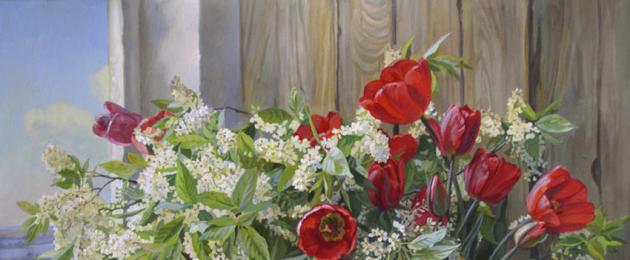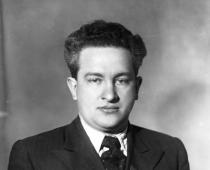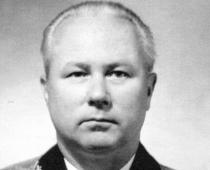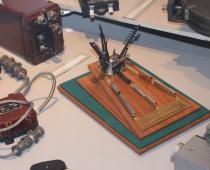"Bird cherry" Sergey Yesenin
Bird cherry
Bloomed with spring
And the branches are golden
What curls, curled.
Honey dew all around
Slides down the bark
Spicy greens under her
Shines in silver.
And next to the thaw,
In the grass, between the roots,
Runs, flows a little
Silver Stream.
Bird cherry
Hanging up, it's worth
And the greens are golden
It burns in the sun.
A rattling wave of a stream
All branches are poured
And smoothly under the steep
She sings songs to her.
Analysis of Yesenin's poem "Bird cherry"
In the early work of Sergei Yesenin, there are a lot of works that are dedicated to the beauty of native nature. This is not surprising, since the poet's childhood and youth were spent in the picturesque village of Konstantinovo, where the author learned not only to understand and appreciate the world around him, but also to notice any little things that characterize his transformation.
Yesenin often said that spring is his favorite season, as he can watch nature awaken after hibernation. In the poet's work, this period symbolizes new hopes and dreams, and also often reflects the elation experienced by the author. The poem "Bird cherry", created by the poet in 1915, is just such in its emotional coloring.
Using the imagery and flexibility of the Russian language, Yesenin endows an ordinary tree with human qualities, presenting a bird cherry in the image of a young girl who “twisted golden branches like curls”. The amazing harmony of the surrounding world cannot leave the poet indifferent, and he notes how "honeydew" slides down the trunk of a bird cherry, and a "small silver stream" flows near its roots.
The spring awakening of nature inspires romantic thoughts on the poet, therefore the image of a stream in the poem symbolizes a young man in love who is just beginning to discover this gentle and exciting feeling. Therefore, Yesenin draws a parallel between the world of people and nature, focusing on the fact that the bird cherry and the brook remind him of young lovers who do not dare to confess their feelings to each other. The quivering bird cherry is beautiful in its timid beauty, and its “golden greens are burning in the sun”. As for the brook, he gently irrigates its branches with melt water and "sings a song, insinuatingly, under a cooler song."
The figurative perception of the world is characteristic of all the works of Yesenin's landscape poetry without exception. He knew how to see what others did not notice in the daily hustle and bustle, and found such precise and delightful words to convey the beauty of ordinary natural phenomena that few could remain indifferent to his poems. In later lyric works, the author more and more often depicted a snowstorm and a cold autumn rain, which in their essence were consonant with the poet's mood. However, the landscape lyrics of the initial stage of Yesenin's work are painted in gentle and juicy tones, filled with purity, joy and serenity.
On the edges of the forest, along the banks of rivers and lakes, in wet ravines and on the slopes of ravines, bird cherry blossoms around mid-May. The blooming bird cherry is a milestone that separates the two periods of spring. The bird cherry blossomed, which means that the green spring is over and late spring, or pre-summer, is coming. Before the bird cherry has time to bloom, lilacs, cherries, apple trees, acacia bloom behind them ...
Well, while only bird cherry blossoms, no other tree can boast of a snow-white outfit. And it seems that there is no person who could not solve the riddle:"Mother in the spring in a white dress, stepmother in the winter in the same shroud."
Against the background of the white boiling of flowers, the almost black trunk of the bird cherry stands out sharply. Bird cherry is the only tree in the northern regions that has such a bark. Scientists speculate that it was the bark that gave the tree its name. In ancient times, the word"Bird cherry"was formed from the now disappeared word"Cherma" , which translated into modern language means"dark"... And if the dryads living in the trees were not a poetic fiction, then the bird cherry dryad could be represented as a swarthy beauty in a white and light, like bird cherry blossom, sarafan. Many folk signs are associated with the flowering of bird cherry."When flowers bloom on a bird cherry - the end of the black grouse"- say the hunters. And fishermen have their own omen:"When the bird cherry blossoms, then the catch of bream"... Carefully looked at bird cherry and grain growers."This wheat when the bird cherry blossoms"They reminded each other.

The bird cherry blossoms in the forest, and mosquitoes appear as if awakened by the stifling aroma of bird cherry flowers. And soon frogs begin to give their first concerts.
In all parts of the bird cherry there are a large amount of volatile substances that kill pathogenic microbes, the so-called phytoncides. Now phytoncides are found in many trees. Although phytoncides were discovered by science relatively recently, they found practical application even in ancient times. Back in the 18th century. One Russian magazine wrote that peasants covered themselves and their livestock with bird cherry branches to protect themselves from damage and witchcraft. Corruption and witchcraft were, of course, common contagious diseases. Not knowing how to explain the disinfecting effect of bird cherry branches, they attributed magical properties to them. The peasants have long noticed that it is only necessary to bring the branches of flowering bird cherry into the hut at least for one night at a time when somewhere behind the stove a brooding hen is sitting on the eggs, the eggs will become chatterboxes. Of course, this was also attributed to magical power. But now we know that this is the result of the action of phytoncides, which at a distance can kill not only an embryo in an egg, but even a mouse. In mid-May, on the table of another city apartment, it is not uncommon to see a huge broom bouquet with half-fallen flowers. Needless to say, the owner of the broom bouquet is not only barbaric towards nature, but also completely devoid of taste. And it's good that bird cherry, even ruined, can stand up for itself. The owner of the bouquet is unaware that poor health and headaches in the morning are a direct consequence of the bird cherry aroma.

In folk medicine, infusion of bird cherry flowers has long been used as a lotion for eye diseases. "Bird cherry water", obtained by distilling flowers with water, can now be bought at the pharmacy.

Bird cherry leaves, especially dried ones, have a pleasant smell of almonds. They really, like bark, berries and wood, contain bitter almond oil. Scented tea made from bird cherry leaves is an ancient medicine used for lung diseases, colds and other diseases. For medicinal purposes, infusions of bird cherry bark were used. She also went to the manufacture of burgundy and green paints. Bast fibers, called sarga, were used by folk craftsmen to overlap boxes, naberukh and other wood chips bent from pine, linden and aspen shingles. When soaked, sarg ribbons have high elasticity, and when dry, they become very durable.

In summer, the fruits collected in a brush ripen on the bird cherry. In other fruitful years, leaves are not visible behind bird cherry berries. Whether the harvest of bird cherry will be large can be determined in spring by the green ovaries that appeared immediately after flowering."Many ovaries on bird cherry - to the harvest of rye", - says the popular belief. Bunches of large cast fruits seem to have been carved from black precious stones by some talented Ural craftsman. At this time, near the tempting berries, you can meet starlings and, of course, boys. Sweet but tart berries are mouth-tightening, but not easy to pull away from. And, perhaps, for this in some areas they call bird cherry a swallow.
Bird cherry berries contain malic and citric acids, sugar, almond oil, vitamins and tannins.

Once upon a time in the Urals, the Russian North and in Siberia, bird cherry berries were prepared on a par with bread."The berry is small, but the whole world is cute", - said the Siberians affectionately. Harvested ripe berries were dried in large baking trays in a free Russian oven, and then, like the grain, were transported in bags to the mill. They came back from the mill with sacks of pink-brown flour, smelling of fragrant almonds. The hostess's bird cherry flour was mixed with rye or wheat flour and the dough was mixed with this mixture. The bread baked from such flour was scented and had a peculiar, very pleasant taste. The same flour, only with granulated sugar, was steeply brewed with boiling water, and then a delicious and nutritious bird cherry talker was obtained. Flour was also used for filling the pies. If before the revolution bird cherry flour was harvested to some extent due to the lack of natural rye or wheat flour, now, harvested in small quantities, it is used to prepare original ancient dishes that Siberians and northerners eat, as they say, “from the hunt ". Bird cherry flour can be bought in stores in large cities of Siberia and the Urals.
From dried and fresh berries of bird cherry, healthy and tasty burgundy jelly is still cooked in the villages. Infusion of bird cherry berries and compote have been used since ancient times as an astringent and antiscorbutic agent.
The wood of the bird cherry was used by wood-breeders for various works as a valuable ornamental material. Bird cherry is a sound breed. The trunk has a light yellow wide sapwood and a brown kernel with an olive or reddish-brown tint. Annual layers in all three sections are poorly visible. A narrow dark stripe runs between them.

The medullary rays are numerous and small, but quite clearly distinguishable with the naked eye in the form of light stripes on the transverse section and short dark stripes on the tangential section.
Bird cherry wood is heavy, strong, dense and flexible, it does not split well. Accepts mordant well and stains evenly. After polishing and polishing, it easily acquires an intense vitreous luster. In older trees, the wood becomes reddish-brown over time.
When processing fresh wood, a specific almond smell is felt, similar to the smell of mountain ash wood. Bird cherry dries out a little, but you need to dry it very carefully. Well-dried wood does not warp or crack. Thanks to its uniformity, it cuts well in all directions. Bird cherry enjoys well-deserved fame among carpenters, turners and woodcarvers. Its wood is especially good for carving with fine modeling of small details. On one old roll, dating back to the last century, the carver made the following inscription with a knife:“1846 July 1 day of affairs (al) Matvey Novoselov on a ship in a large artel in a rainy time. The bird cherry tree was cut in Vologda. "In the inscription, the master conscientiously indicated the place and time of making the roll. Such inscriptions are common, but the material from which the product is made is not often indicated. In this case, not only the type of wood is indicated, but also the place where it was harvested. This testifies to the great importance that the master attached to bird cherry wood, which was considered the best for this kind of products. After all, the roller with which the laundry was knocked out during rinsing had to withstand a variety of loads during operation. This means that the tree should be heavy, durable, not afraid of moisture, not crack, warp and not stain the linen. Of course, rolls were made quite often from the wood of other trees, for example, aspen or birch, but bird cherry wood was considered one of the best for this purpose.
Sergey Yesenin
Bird cherry
Bird cherry
Bloomed with spring
And the branches are golden
What curls, curled.
Honey dew all around
Slides down the bark
Spicy greens under her
Shines in silver.
And next to the thaw,
In the grass, between the roots,
Runs, flows a little
Silver Stream.
Bird cherry
Hanging up, it's worth
And the greens are golden
It burns in the sun.
A rattling wave of a stream
All branches are poured
And smoothly under the steep
She sings songs to her.
Yesenin! Golden name. The murdered lad. The genius of the Russian land! No other Poets who came to this world possessed such spiritual strength, enchanting, all-powerful, soul-capturing childish openness, moral purity, deep pain and love for the Fatherland! Over his poems, so many tears were shed, so many human souls sympathized and empathized with every Yesenin line, that if it were counted, Yesenin's poetry would outweigh any and by much! But this method of assessment is not available to earthlings. Although one could see from Parnassus - the people did not love anyone so much! With Yesenin's poems they went into battle in the Patriotic War, for his poems they went to Solovki, his poetry excited souls like no one else ... God alone knows about this holy love of the people for their son. Yesenin's portrait is squeezed into the wall family photo frames, placed on the goddess along with the icons ...
And not a single Poet in Russia has yet been exterminated or banned with such frenzy and stubbornness as Yesenin! And they forbade, and hushed up, and belittled in dignity, and poured mud - and they do it to this day. It is impossible to understand why?
Time has shown: the higher Poetry is by its secret lordship, the more embittered are the envious-losers, and the more imitators are.
Another great gift of God to Yesenin - he read his poems as uniquely as he created them. They sounded so in his soul! All that remained was to say. Everyone was shocked by his reading. Note, the great Poets have always been able to uniquely and by heart read their poems - Pushkin and Lermontov ... Blok and Gumilyov ... Yesenin and Klyuev ... Tsvetaeva and Mandelstam ... So, young gentlemen, a poet who mumbles his lines on a piece of paper from the stage is not a Poet, but an amateur ... A poet may not be able to do many things in his life, but not that!
The last poem "Goodbye, my friend, goodbye ..." is another mystery of the Poet. In the same 1925, there are other lines: “You don’t know that life is worth living!”
Yes, in the deserted city lanes, not only stray dogs, "smaller brothers", but also big enemies listened to Yesenin's easy gait.
We must know the true truth and not forget how his golden head was thrown back like a child ... And again his last breath is heard:
"Dear ones, good, good ..."
Bird cherry
Bloomed with spring
And the branches are golden
What curls, curled.
Honey dew all around
Slides down the bark
Spicy greens under her
Shines in silver.
And next to the thaw,
In the grass, between the roots,
Runs, flows a little
Silver Stream.
Bird cherry
Hanging up, it's worth
And the greens are golden
It burns in the sun.
A rattling wave of a stream
All branches are poured
And smoothly under the steep
She sings songs to her.
Analysis of the poem "Bird cherry" by Yesenin
Most of the early work of S. Yesenin is devoted to landscape lyrics. The young peasant poet strove to reveal to his readers the wonderful world of Russian nature. Memories of his native village allowed Yesenin to create very pure soulful works that accurately conveyed his feelings. One of them is the poem "Bird cherry" (1915).
In the center of attention of an enthusiastic observer is the "fragrant bird cherry". An ordinary tree is completely transformed with the onset of spring. Bird cherry appears in the guise of a young beautiful girl who curled her curls. She is aware of her dazzling beauty, which gives her even more charm.
Bird cherry blossoms together with all the surrounding nature. Yesenin uses a rich color palette in the image of the landscape: "golden branches", "green", "in silver". The dynamism of the general picture is given by the flowing "silver stream", which sings "songs" to the bird cherry. Thus, the image seems to come to life, filled with a variety of sounds.
Bird cherry and a stream can symbolize two lovers, whose feelings were awakened for the first time under the influence of spring. The "insinuating" singing of the brook resembles an ardent declaration of love of a young man. Endowing plants and animals with human traits in general was Yesenin's favorite technique, which did not separate man from nature.
A characteristic feature of Yesenin's landscape lyrics is the absence of a lyrical hero. The figure of the observer is only assumed. The poet allows readers to look at the magical picture with their own eyes.
The work is written in a very simple and understandable language. Various epithets give it special beauty and lyricism: "fragrant", "honey", "rattling". A common technique for Yesenin's early lyrics is the use of personification: "dew ... creeps down", "stream ... sings." The poet also uses original metaphors: "greenery ... burns in the sun", "rattles all the branches with a rattling wave." The only comparison ("like curls") will become traditional for Yesenin and will subsequently be used very often by him.
The spring transformation of nature was not chosen by Yesenin by chance. It was very close to his own condition during this period. The young poet recently moved to Moscow. He is full of hope and self-confident. Yesenin associated the entry into the poetic world with the beginning of a new life. He was in a state of powerful spiritual uplift. This feeling became the "calling card" of the new Russian poet, with the help of which he managed to conquer the discerning Moscow public.
- In contact with 0
- Google+ 0
- OK 0
- Facebook 0








